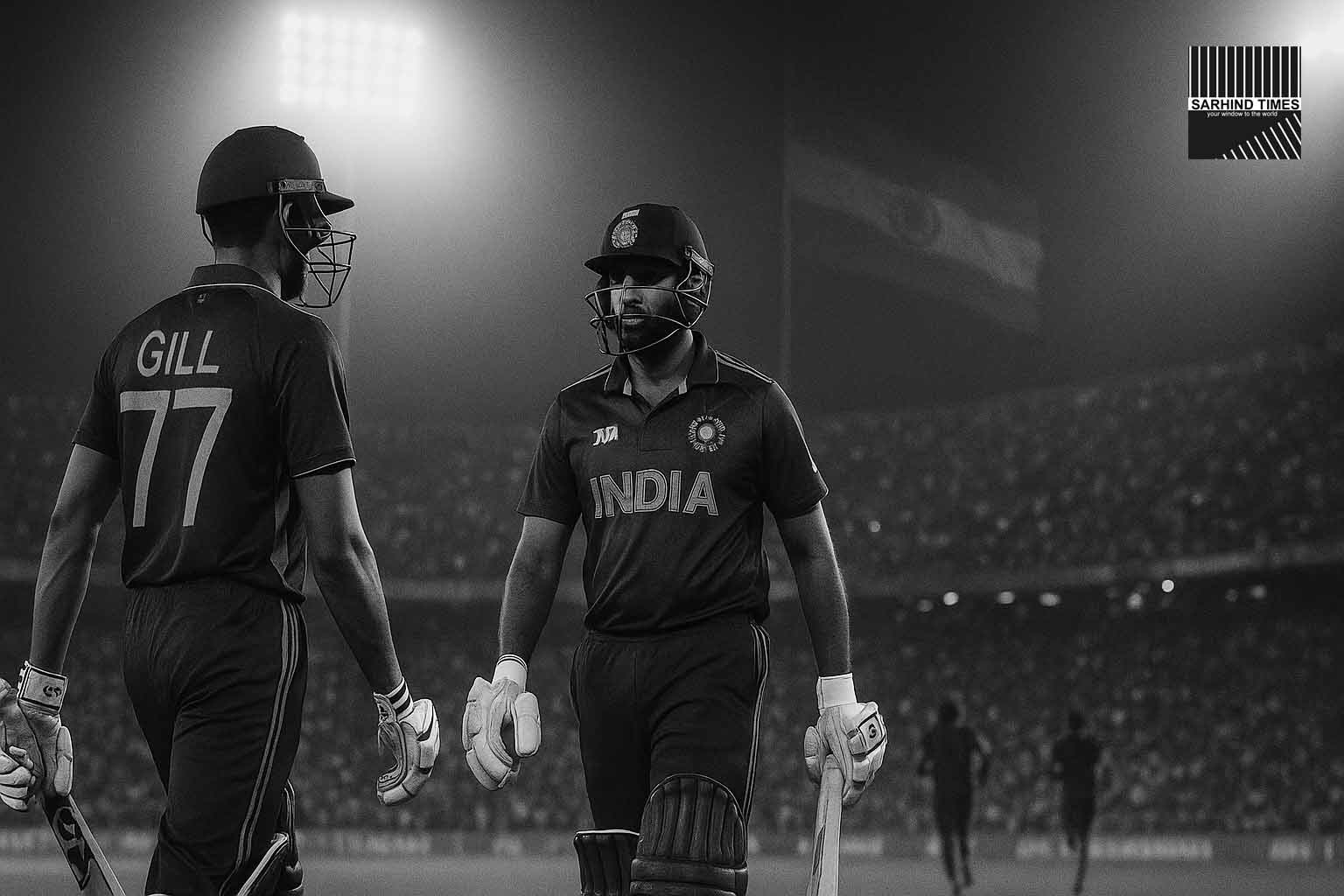A generational shift takes shape as India’s next cricket leader steps into the spotlight
(By Sarhind Times Sports Bureau | October 16, 2025)
Mumbai — A New Chapter in Indian Cricket Leadership
As the Indian men’s cricket team prepares to face Australia in the upcoming three-match ODI series beginning October 19, the spotlight turns firmly to Shubman Gill — the young batting prodigy from Punjab — who officially begins his tenure as India’s ODI captain.
At 26, Gill becomes one of the youngest captains to lead India in the modern era, succeeding Rohit Sharma in a transition that marks both continuity and change. With Rohit and Virat Kohli still active in the setup, Indian cricket stands at the crossroads of experience and evolution.
“Every team has its generational handover. Ours will be defined by mutual respect and shared intent,” said a senior BCCI official, describing the Gill appointment as “a seamless succession built on trust.”
The Transition: Graceful, Not Abrupt
The leadership shift was carefully calibrated. Sources indicate that Gill’s appointment came after multiple internal reviews and consultations between head coach Rahul Dravid, chief selector Ajit Agarkar, and the senior players group, including Rohit Sharma and Virat Kohli.
While Rohit has captained across formats with distinction—leading India to the 2023 World Cup final and Asia Cup triumph—selectors reportedly felt the need to groom the next core of leaders with the 2027 ODI World Cup in mind.
“Shubman represents the new age of Indian cricket — analytical, composed, and unflustered under pressure,” said Rahul Dravid, speaking to Sarhind Times. “This isn’t a baton drop; it’s a baton pass.”
Gill himself met Rohit Sharma earlier this week at the NCA, where the two reportedly discussed team strategy, batting combinations, and leadership philosophy.
Legacy of Mentorship: Kohli and Dhoni’s Influence
In the pre-series briefing, Virat Kohli reflected on leadership transitions through the years, recalling the mentorship he received from MS Dhoni and coach Gary Kirsten.
“The best captains are those who create clarity for others,” Kohli said. “MS did that for me. I’m sure Shubman will do it his way—quietly, but with conviction.”
Insiders say Gill has leaned heavily on advice from both Kohli and Rohit during his formative years. His composure, minimalism, and methodical preparation are reminiscent of the traits both predecessors valued most.
Tactical Preview: The Gill Blueprint
The Australia series will be the first real test of Gill’s captaincy instincts. The opposition, ranked among the world’s most aggressive ODI units, offers the ideal crucible for assessing Gill’s tactical mettle.
Analysts expect three areas of experimentation:
- Batting Order Fluidity:
Gill could promote Ruturaj Gaikwad or Sanju Samson into top-order roles to test stability beyond Rohit and Kohli. - Spin Combination:
India’s spin attack, anchored by Kuldeep Yadav, may see inclusion of Washington Sundar for balance in middle overs. - Powerplay Approach:
Under Gill, the team might pursue a more assertive batting tempo, using aggressive shot-makers early on to exploit field restrictions.
“Shubman’s leadership will likely echo his batting style—clean, measured, and risk-aware,” said Saba Karim, former national selector. “Expect tactical evolution, not revolution.”
Workload Management: The Selector’s Balancing Act
The selectors have made it clear that the next 12 months will prioritize workload rotation and depth-building. With the T20 World Cup 2026, the Champions Trophy, and a full home Test calendar, India’s schedule is among the most congested in world cricket.
The ODI series against Australia will thus serve as a laboratory for bench strength — testing backup pacers like Mukesh Kumar, Avesh Khan, and all-rounders like Rinku Singh.
“We’ve built enough depth to compete in parallel formats,” said chief selector Ajit Agarkar. “Gill’s challenge will be to identify leaders within leaders.”
The Numbers Behind the Narrative
Shubman Gill’s meteoric rise is reflected in his record:
- ODI Average: 63.4
- ODI Centuries: 12 (including a double hundred vs New Zealand)
- Strike Rate: 99.6
- Age when appointed captain: 26
These statistics place him among India’s most prolific batters in early career phases—on par with Kohli’s early ODI record.
His calm body language and tactical awareness during IPL captaincy for Gujarat Titans further reinforced his credentials.
The Australia Challenge
Australia, led by Pat Cummins, arrives with a full-strength lineup — including David Warner, Steve Smith, and Marnus Labuschagne — signaling their intent to test India ahead of next year’s ICC ODI Championship window.
The matches, scheduled for Chennai, Nagpur, and Rajkot, will examine India’s adaptability to varying pitch conditions — from spin-friendly surfaces to batting belters.
“Facing Australia is the ultimate stress test for any captain,” said Sunil Gavaskar. “It reveals whether your tactical rhythm can match your temperament.”
Gill, known for his elegant stroke play, has already scored three centuries against Australia across formats. But this series, observers say, will judge his decision-making under duress more than his runs.
Changing of the Guard: Fans React
Across social media, fans have hailed Gill’s elevation as the dawn of a new era. The tag #GillEraBegins trended nationally within hours of the announcement.
Young fans view him as a relatable, contemporary face of Team India — disciplined yet digitally savvy, composed yet expressive on the field.
“He represents the calm of Dhoni and the technique of Kohli,” wrote one fan on X.
Veteran supporters, while nostalgic about the Rohit–Kohli–Dhoni lineage, acknowledge the necessity of succession planning in a modern sporting ecosystem that demands long-term continuity.
Inside the Dressing Room: Mutual Respect
Reports suggest a remarkably healthy dynamic between Gill and senior players. Rohit, slated to open alongside Gill in the first ODI, has reportedly encouraged the youngster to “trust his instincts and not second-guess under pressure.”
Kohli, meanwhile, continues to emphasize the collective culture that binds India’s cricketing eras together.
“The jersey doesn’t change, only the hands that guide it do,” Kohli said in a recent motivational address to teammates at the NCA.
This camaraderie reflects a deliberate cultural continuity that the BCCI and team management have cultivated — a bridge between legacy and evolution.
Coach Dravid’s Role: Transition Architect
Rahul Dravid’s calm stewardship has been instrumental in easing leadership transitions. The former India captain, known for mentoring young players, has ensured that leadership changes are process-driven, not personality-driven.
“Dravid’s greatest contribution is institutional stability,” remarked Harsha Bhogle. “He ensures that new captains inherit systems, not stress.”
Dravid’s support team, including bowling coach Paras Mhambrey and fielding coach T. Dilip, have reportedly created a modular leadership framework that decentralizes authority — allowing younger captains to grow organically without fear of failure.
A Broader Vision: Building for 2027
With the next ODI World Cup (2027) set to be co-hosted by South Africa, Zimbabwe, and Namibia, the BCCI’s roadmap under Gill’s captaincy focuses on three pillars:
- Leadership depth: Grooming vice-captains and field captains in different conditions.
- Analytical evolution: Greater use of data modeling for opposition analysis.
- Athlete longevity: Monitoring workload, recovery, and emotional resilience.
According to BCCI sources, Gill’s leadership will be evaluated over two cycles — the Australia ODIs and the South Africa tour in December 2025 — before being formalized as a long-term captaincy appointment.
Voices of Experience
Cricketing legends have lauded Gill’s promotion as both bold and necessary.
Kapil Dev: “Captaincy isn’t about aggression; it’s about balance. Gill has both mind and method.”
Sourav Ganguly: “He will bring freshness to the format. Every era needs its own rhythm, and Shubman represents that rhythm.”
Ravi Shastri: “If he keeps communication open and tactics sharp, India’s ODI setup will remain among the world’s best.”
Public Sentiment and Media Landscape
The announcement has reignited mainstream debate about succession planning in Indian cricket, with former selectors and columnists emphasizing the importance of rotational captaincy models.
Editorials in leading dailies have praised the move as “strategically timely” and a “symbolic renewal of Indian cricket’s identity.”
TV broadcasters, meanwhile, are capitalizing on the buzz: Star Sports’ campaign “The Gill Era Begins” and Hotstar’s teaser “Next Gen. Same Passion.” have already gone viral.
The Psychological Angle
Sports psychologists working with the team have reportedly introduced leadership scenario simulations to help Gill navigate high-pressure moments — from DRS disputes to field placement calls in crunch overs.
“Leadership fatigue is real in modern cricket,” said Dr. Shreya Menon, team psychologist. “Gill’s calmness under scrutiny will be his greatest asset.”
Beyond Boundaries: A Global Brand in Making
Off the field, Shubman Gill is quickly emerging as a pan-Asian sporting brand. With endorsement deals across apparel, EV startups, and fintech, he symbolizes the blend of athletic excellence and digital-age influence.
Brand strategists say Gill’s image — youthful yet composed — aligns with India’s broader soft power projection in global sport.
“He could become to cricket what Federer was to tennis — elegance meeting discipline,” said Anand Mahindra, in a social post celebrating the appointment.
Conclusion: A Leadership Evolution, Not a Revolution
As India faces Australia in Chennai for the opening ODI, cricket fans worldwide will witness more than just a bilateral contest. They’ll see the first frames of a generational handover — one built on mentorship, mutual respect, and modernity.
The Shubman Gill era, at its core, represents a quiet redefinition of leadership — where experience isn’t replaced, but reimagined.
If the journey of Indian cricket from Dhoni to Kohli to Rohit symbolized evolution through intensity, Gill’s chapter may well embody evolution through intellect.
For now, India’s future stands tall at the crease — calm eyes behind the helmet, bat poised, ready to lead.
#TeamIndia #ShubmanGill #RohitSharma #ViratKohli #INDvAUS #Cricket #ODI #BCCI #IndianCricket #GillEraBegins #RahulDravid #SportsLeadership

























+ There are no comments
Add yours